 |
 |
 |
| |
Dose selection and pharmacokinetics-pharmacodynamics of darunavir coadministered with low-dose ritonavir in the DELPHI (TMC114-C212) trial in treatment-experienced, HIV-1-infected children and adolescents
|
| |
| |
Reported by Jules Levin
IAC Mexico City Aug 3-8, 2008
Vanitha Sekar,1 Tom Van de Casteele,2 Ben Van Baelen,2 Peter Vis,2,3 Ludo Lavreys,2 Rudi De Greef,2Martine De Pauw,2 Sabrina Spinosa-Guzman,2 Richard M Hoetelmans2
1Tibotec Inc., Yardley, PA, USA; 2Tibotec BVBA, Mechelen, Belgium; 3Exprimo NV, Mechelen, Belgium
AUTHOR CONCLUSIONS
Treatment with DRV/r was effective and well tolerated in HIV-1-infected children between 6 and 17 years of age, with an AE profile similar to that described for adults.
Appropriate DRV/r doses for pediatric patients are
- 375/50mg bid (for patients weighing 20-<30kg)
- 450/60mg bid (30-<40kg)
- 600/100mg bid (340kg).
The target adult DRV exposures were achieved across weight bands, confirming appropriate dose selection in the trial.
The protein binding-corrected EC50 value for resistant virus of 550ng/mL was exceeded in all children.
Consistent with findings in adults, subgroup PK analyses showed no clinically relevant effect of race, gender, nor any effect of efavirenz or tenofovir coadministration on DRV exposure.
No clinically relevant relationships between DRV pharmacokinetics and either efficacy or safety were found in this pediatric population at Week 24.
INTRODUCTION
Darunavir (DRV; TMC114) with low-dose ritonavir (DRV/r; RTV) at a dose of 600/100mg bid has been approved in the USA1 and other countries2 for the treatment of HIV-1 infection in treatment-experienced adult patients.
DELPHI (Darunavir Evaluation in Pediatric, HIV-Infected, treatment-experienced patients; TMC114-C212) is an ongoing, open-label, Phase II study of DRV/r in HIV-1-infected, treatment-experienced children aged 6-17 years.
The DELPHI study is structured in two parts
-- Part I evaluated the pharmacokinetics of two different doses of DRV/r administered bid over a 2-week period, with the objective of providing dose recommendations3
-- Part II is evaluating long-term safety, tolerability and efficacy of DRV/r at the recommended pediatric dose.
At Week 24, 64% of patients achieved a viral load of <400 copies/mL and 50% reached <50 copies/mL (intent-to-treat, time-to-loss-of virologic response algorithm).4 DRV/r was generally safe and well tolerated with most adverse events (AEs) being grade 1 or 2 in severity.4
In trials in HIV-infected adults, analysis of the pharmacokinetics and pharmacodynamics (PD) of DRV/r revealed no relevant relationship between drug exposure and either efficacy or safety5-7
-- no relationship was seen with either DRV/r 600/100mg bid (POWER and TITAN) or 800/100mg qd (ARTEMIS).
This analysis describes DRV/r dose selection performed at Week 2 as well as the relationship between DRV pharmacokinetics and efficacy/safety in pediatric patients at the Week 24 primary analysis of DELPHI.
METHODS
Patients and study design
DELPHI is an ongoing, two-part, open-label, Phase II study to select DRV/r doses and evaluate pharmacokinetics, safety and efficacy of DRV/r in HIV-1-infected, treatment-experienced children aged 6-17 years.
Patients were male or female HIV-1-infected children weighing between 20kg and 50kg, had received a stable antiretroviral (ARV) regimen for at least 12 weeks, and had plasma HIV-1 RNA concentration >1000 copies/mL at screening.
Among the exclusion criteria were use of efavirenz in the current regimen (Part I only) and presence of any currently active AIDS-defining illness.
In Part I (dose selection), patients were randomized in a 1:1 ratio to receive one of two DRV/r weight-based doses using allometric models, together with an optimized background regimen consisting of at least two ARVs
-- dose Group A received the weight-adjusted adult-equivalent dose of DRV/r 600/100mg bid (Figure 1)
-- dose Group B received a 20-33% higher dose of DRV than Group A (Figure 1).
After 2 weeks of treatment, DRV/r doses were selected by weight (three bands) based on pharmacokinetics, safety and change in viral load
-- in Part II, all patients participating in Part I were switched to the recommended dose and additional patients (n=20) were enrolled to receive this selected dose. An additional 12 patients weighing 50kg and more were included.
The study protocol was reviewed and approved by the appropriate institutional ethics committee(s) and health authorities, and the study was conducted in accordance with the Declaration of Helsinki. Parents or legal representatives and patients (where appropriate, depending on age and local regulation) had to be willing and able to give consent. Children were informed about the trial and asked to give assent.
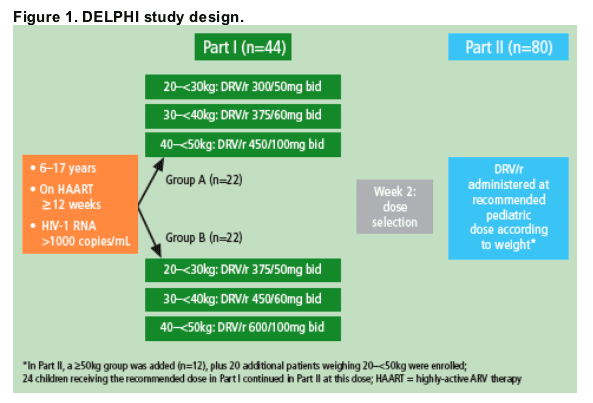
Pharmacokinetic (PK) and PD analysis
For patients participating in Part I, blood samples were taken at five timepoints (predose, 1, 3, 6 and 12 hours post-dose) on Day 14 to determine the DRV and RTV area under the curve from administration to 12 hours post-dose (AUC12h) and trough concentration (C0h)
-- pharmacokinetics of DRV and RTV on Day 14 were determined using
noncompartmental analysis.
Following Part I, sparse blood sampling was performed for Part II patients at Week 2 and all patients at Weeks 4 and 24 to determine steady-state DRV AUC12h and C0h
-- PK parameters of DRV were estimated using population PK analysis
-- the existing model in adults was updated to take into account the body weight, using the data collected at Week 2 combined with similar adult data from patients receiving DRV/r
-- the updated model was used to perform an empirical Bayes analysis to determine the individual pharmacokinetics of DRV for all children.
The relationship of DRV pharmacokinetics to efficacy or safety at the Week 24 primary analysis timepoint was investigated using descriptive methods
-- PK-efficacy relationships were assessed for change in log10 viral load from baseline and percentage of patients achieving plasma viral load <50 copies/mL
-- PK-safety relationships were assessed for occurrence of AEs of interest (rash-, cardiac-, lipid-, glucose-, liver-, and gastrointestinal-related AEs).
RESULTS
Patient characteristics
In Part I, 44 patients were randomized to dose Group A or Group B (22 in each group).
In Part II, 80 children (44 from Part I plus 36 additional patients) received the DRV/r dose selected on the basis of results from Part I.4
Patient demographics were similar between Parts I and II. The majority of patients overall were Caucasian (54%), male (71%) and 70% were aged 12 years or above.
The overall trial population had advanced HIV disease with a mean time since diagnosis of 10.7 years; mean baseline viral load was 4.64 log10 copies/mL and the median baseline CD4 cell count was 330 cells/mm3.
Most patients had previously received ARVs from at least three classes (75%) and at least one protease inhibitor (PI) (96%).
Pharmacokinetics were evaluable in 74 children.
Dose selection
At the end of Part I, DRV and RTV plasma concentrations were available for all 44 patients and PK analyses were conducted on 41 patients (three were excluded for protocol violation [n=2] or absence of detectable RTV in plasma [n=1]).
For pediatric data, AUC24h was calculated (AUC12h x 2) to allow comparison with adult data.
Overall, the mean DRV exposure in HIV-1-infected children in Group B was comparable to, or slightly higher than, the reference exposure in adults administered DRV/r 600/100mg bid (Figure 2), while exposure in Group A was slightly lower than in adults
-- in Group A, mean values of DRV AUC24h, C0h and maximum plasma concentration (Cmax) were 81%, 91% and 88%, respectively, of the corresponding mean adult PK parameters
-- in Group B, mean values of DRV AUC24h, C0h and Cmax were 102%, 114% and 112%, respectively, of the corresponding mean adult PK parameters.
Figure 2. Comparison of PK parameters versus body weight for Groups A and B (DELPHI Part I) for (a) DRV AUC24h and (b) DRV C0h. Shaded box represents 95% confidence intervals of adult AUC24h data.
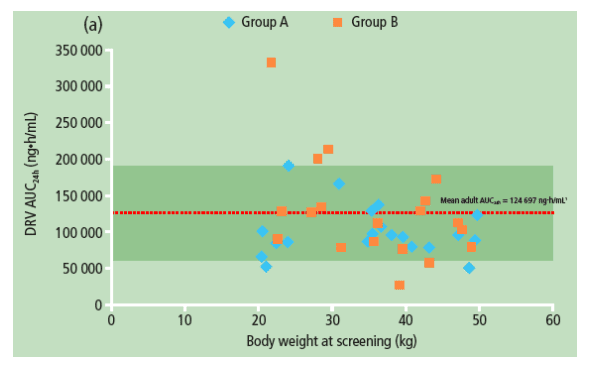
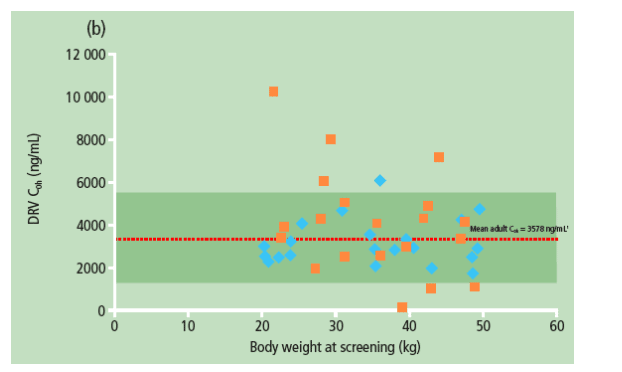
Both dose groups met the protocol-specified criteria for PK evaluations in that the mean values fell within 80-130% of the corresponding treatment-experienced adult PK parameters.
Based on these data, together with safety and efficacy data, the Group B dose (DRV 11-19mg/kg and RTV 1.5-2.5mg/kg bid) was selected as being appropriate for children and adolescents i.e. DRV/r 375/50mg bid for patients weighing 20-<30kg; 450/60mg bid for patients 30-<40kg and 600/100mg bid for patients 340kg.3
Pharmacokinetics in Part II
DRV sparse sampling data was available for 74 patients in the population PK analysis at Week 24.
For all patients, DRV C0h exceeded the EC50 value for PI-resistant HIV-1 strains (550ng/mL; based on in-vitro data and corrected for protein binding) (Table 1).
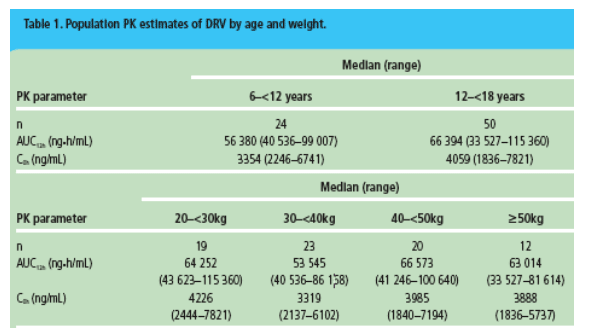
Target DRV exposures were achieved across age groups and weight bands.
Gender and race did not appear to influence DRV pharmacokinetics
-- female patients had a slightly higher DRV AUC12h and C0h compared with male patients (Figure 3), however, these results were not considered clinically relevant
-- race did not appear to influence DRV pharmacokinetics (Figure 3).
Figure 3. Median, 25% and 75% percentiles, minimum and maximum of DRV AUC12h and C0h by gender and race.
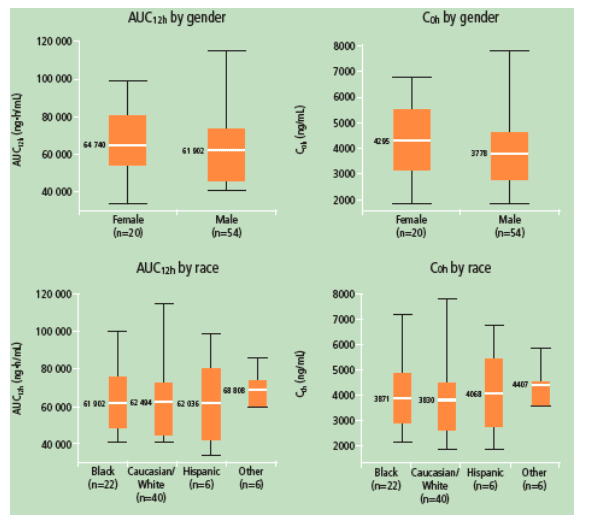
DRV exposure was not affected by coadministration with efavirenz or tenofovir.
Findings for these subgroup analyses were consistent with those in HIV-infected adults.7,8
Relationship between PK and efficacy
There was no relevant relationship identified between PK parameters and virologic response. DRV C0h values were not related to the observed proportion of patients achieving plasma viral load <50 copies/mL (Figure 4). Similar trends were apparent for AUC12h.
Figure 4. Observed virologic response at Week 24 (<50 copies/mL; ITT-TLOVR) by quartile ranges of DRV C0h.
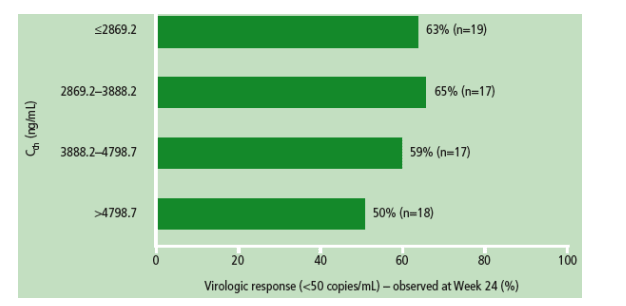
In addition, the observed change in log10 viral load from baseline to Week 24 was consistent across the range of DRV C0h (Figure 5) quartiles studied, with no relevant relationship identified.
Figure 5. Observed change in log10 HIV-1 RNA from baseline at Week 24 by quartile range of DRV C0h.
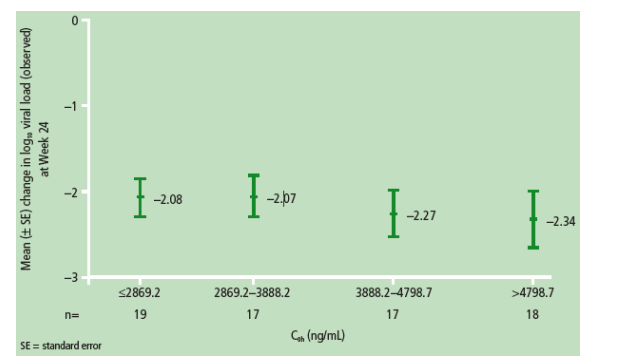
Relationship between PK and safety
In this population of pediatric patients, DRV/r was generally well tolerated with an AE profile similar to that observed in adults
-- during the treatment period, one patient permanently discontinued due to an AE, considered unrelated to DRV/r treatment.
Patients experiencing AEs of interest had median exposure values that were comparable to those observed in patients not experiencing such AEs. Thus, no apparent relationships were observed between DRV C0h and occurrence of rash-, cardiac-, lipid-, liver- or gastrointestinal-related AEs (Figure 6). Similar trends were seen for AUC12h.
Figure 6. Number of patients experiencing AEs of interest (regardless of severity or causality) according to DRV median C0h.
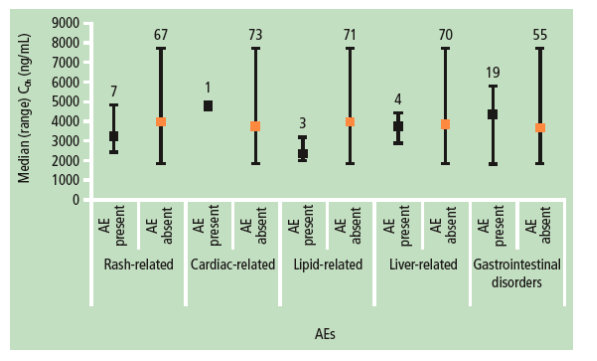
REFERENCES
1. Tibotec Inc. PREZISTATM (darunavir) Prescribing Information. Revised February 2008 (accessed 20 May 2008). Available from:
www.prezista.com.
2. PREZISTATM (darunavir) Summary of Product Characteristics. February 2007 (accessed 20 May 2008). Available from:
http://www.emea.eu.int/humandocs/Humans/EPAR/prezista/prezista.htm.
3. Spinosa-Guzman S, et al. 4th International AIDS Society Conference on HIV Pathogenesis, Treatment and Prevention, Sydney, Australia, 22-25 July 2007. Abstract TUPEB125.
4. Bologna R, et al. 15th Conference on Retroviruses and Opportunistic Infections, Boston, MA, USA, 3-6 February, 2008. Abstract 78LB.
5. Sekar V, et al. 13th Conference on Retroviruses and Opportunistic Infections, Denver, CO, USA, 5-9 February 2006. Abstract J-121.
6. Sekar V, et al. 16th International AIDS Conference, Toronto, Canada, 13-18 August 2006. Abstract TUPE0078.
7. Sekar V, et al. 11th European AIDS Conference, Madrid, Spain, 24-27 October 2007. Abstract P4.1/10.
8. Sekar V, et al. 9th International Workshop on Clinical Pharmacology of HIV Therapy, New Orleans, LA, USA, 7-9 April 2008. Abstract P41.
|
| |
|
 |
 |
|
|